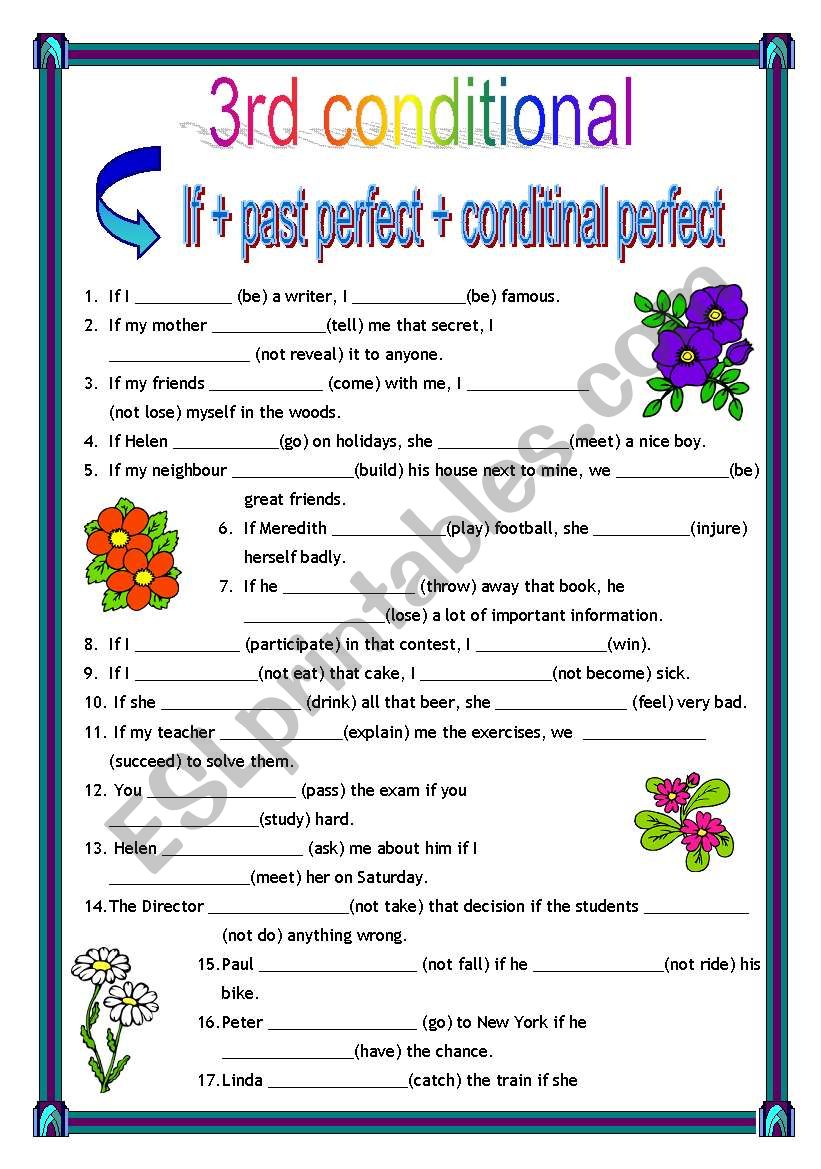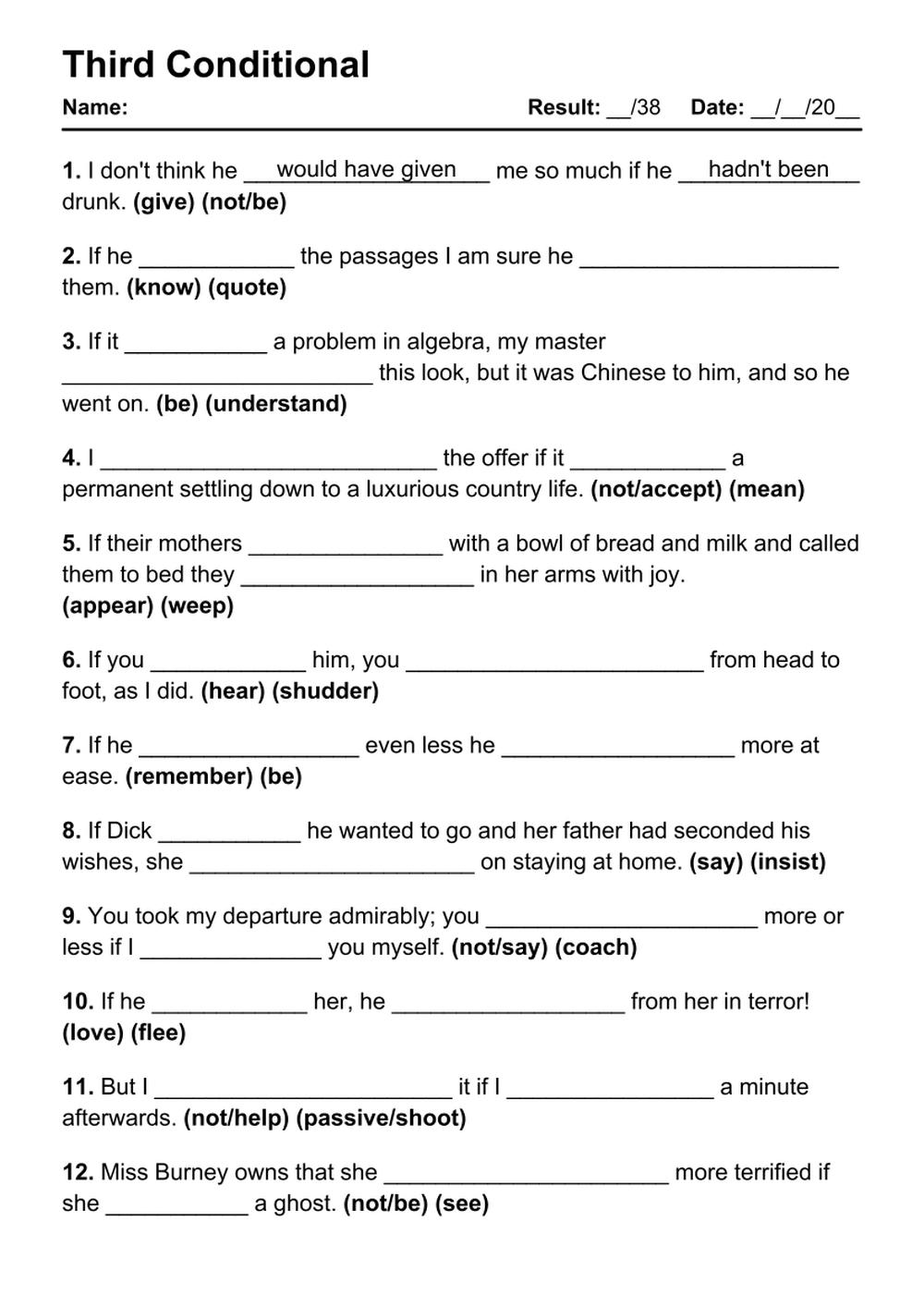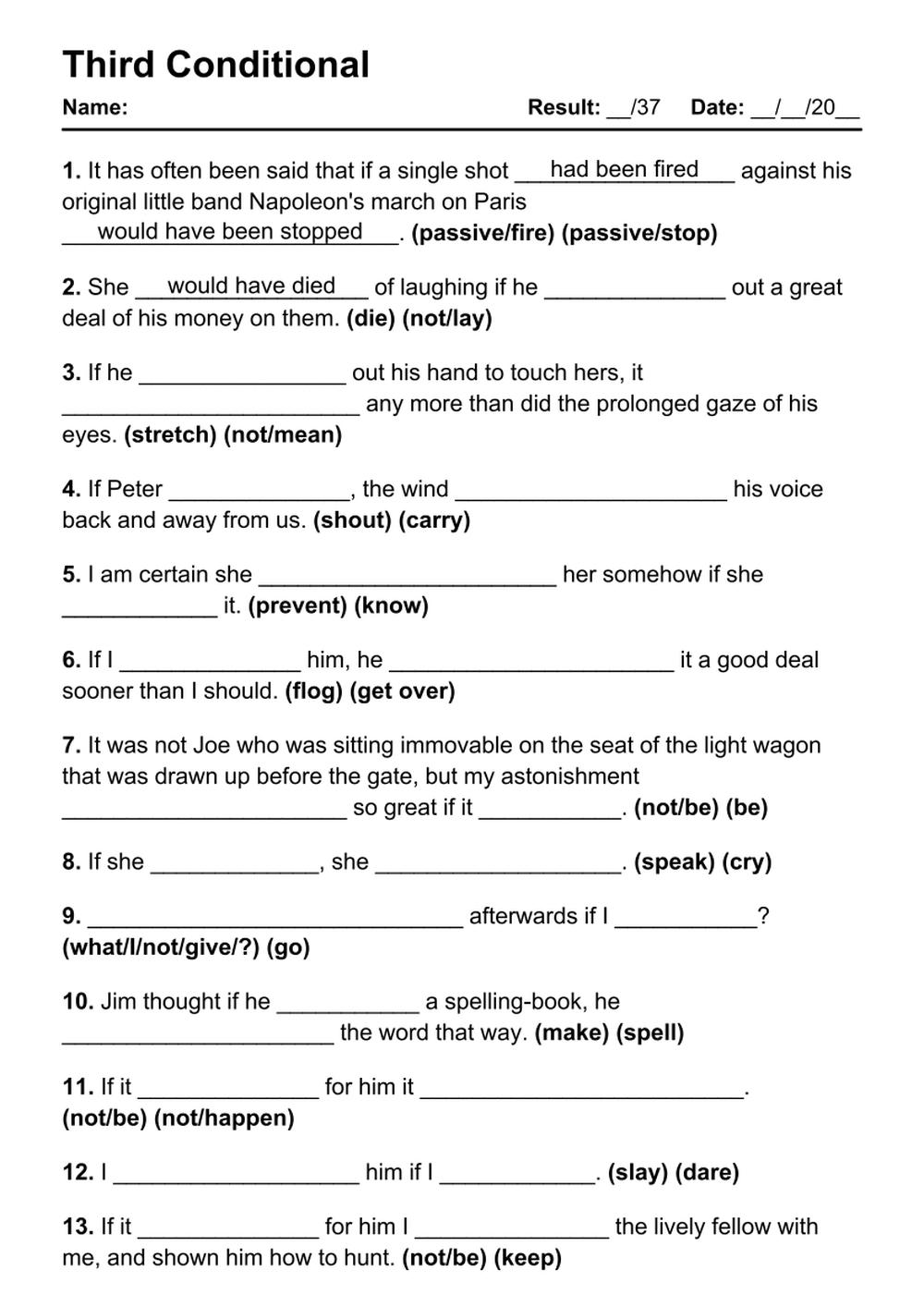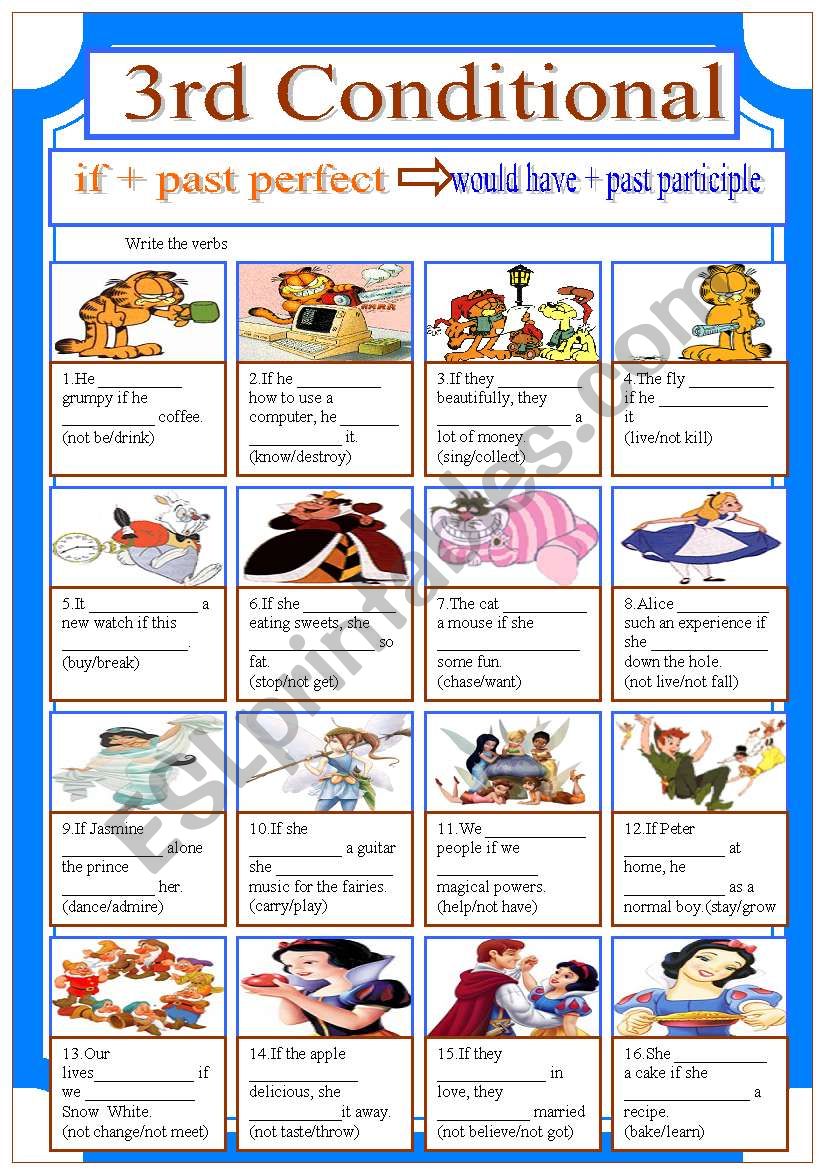
Unlocking Hypothetical Pasts: The Power of Third Conditional Worksheets
The human mind is inherently curious, constantly pondering alternatives, regretting past decisions, and speculating on different outcomes had circumstances been different. This innate desire to explore "what if" scenarios finds its perfect linguistic expression in the third conditional. A cornerstone of advanced English grammar, the third conditional allows speakers and writers to discuss hypothetical situations in the past that did not happen, and their equally hypothetical consequences. Mastering this complex structure is crucial for nuanced communication, enabling learners to express regret, blame, speculation, or simply to reflect on the past.
However, grasping the intricacies of the third conditional – its specific form, meaning, and appropriate usage – often presents a significant challenge for English language learners. This is where the indispensable role of well-designed Third Conditional Worksheets comes into play. These targeted exercises are not merely busywork; they are vital tools that provide structured practice, reinforce grammatical patterns, and help learners internalize this often-tricky grammatical concept.
Understanding the Third Conditional: Form and Function

Before diving into the utility of worksheets, it’s essential to have a solid understanding of the third conditional itself.

Form: The third conditional follows a specific structure:

- If clause (condition):
If + Subject + Past Perfect (had + past participle) - Main clause (result):
Subject + would have + Past Participle


Example: If I had known you were coming, I would have baked a cake.
Function: This structure is used to talk about:
- Hypothetical past situations: These are conditions that were not met in the past. In the example above, the speaker did not know the person was coming.
- Hypothetical past results: These are the consequences that would have occurred if the condition had been met. Since the speaker didn’t know, they didn’t bake a cake.


Essentially, the third conditional is used to express regret, blame, or simply to comment on how things might have been different. It speaks to an irreversible past; the opportunity has passed, and the situation cannot be changed. This contrasts sharply with the first conditional (real future possibilities) and the second conditional (unreal present/future possibilities), making its distinct application critical to master.

The Indispensable Role of Third Conditional Worksheets
Why are dedicated Third Conditional Worksheets so crucial for effective learning? The answer lies in the nature of language acquisition. While theoretical explanations are a good starting point, true mastery comes from active application and repeated practice. Worksheets provide:

- Structured Practice: They break down the complex structure into manageable parts, allowing learners to focus on accuracy before fluency.
- Reinforcement: Repeated exposure to the form and meaning through various exercises helps solidify understanding and recall.
- Application in Context: Good worksheets present scenarios that mirror real-life situations, making the grammar more relatable and memorable.
- Error Identification: By attempting exercises, learners (and teachers) can identify common mistakes, allowing for targeted correction and improvement.
- Confidence Building: Successfully completing exercises builds confidence, encouraging learners to use the structure in their own speaking and writing.
Without focused practice, learners often struggle to move beyond passive recognition of the third conditional to active production. This highlights the necessity of robust and varied Third Conditional Worksheets in any comprehensive English language curriculum.
Types of Third Conditional Worksheets for Effective Learning
To cater to diverse learning styles and address various aspects of the third conditional, a range of worksheet types can be employed:
-
Gap-Filling/Sentence Completion:
- Purpose: To practice the correct conjugation of verbs in both the past perfect (if clause) and ‘would have’ + past participle (main clause).
- Example: If she __ (study) harder, she __ (pass) the exam. (Answers: had studied, would have passed)
- Benefit: Ideal for beginners or as a warm-up, focusing on accurate form.
-
Sentence Transformation/Rewriting:
- Purpose: To deepen understanding of the meaning by converting factual past statements into hypothetical third conditional sentences.
- Example: Fact: I didn’t have money, so I couldn’t buy the tickets. -> Third Conditional: If I had had money, I could have bought the tickets.
- Benefit: Challenges learners to think about cause and effect, and the relationship between reality and hypothetical situations.
-
Error Correction:
- Purpose: To identify and correct common mistakes, such as using ‘would’ instead of ‘would have’, or the simple past instead of the past perfect.
- Example: Find the mistake: If I would have known, I had come. (Correct: If I had known, I would have come.)
- Benefit: Develops an analytical eye for grammatical accuracy and helps learners avoid recurring errors.
-
Matching Exercises:
- Purpose: To connect appropriate ‘if’ clauses with their corresponding ‘main’ clauses, focusing on logical cause-and-effect relationships.
- Example: Match:
- A) If I hadn’t missed the bus,
- B) I would have arrived on time.
- Benefit: Reinforces the logical connection between the hypothetical past condition and its result.
-
Picture Prompts:
- Purpose: To stimulate creative thinking and encourage the production of original third conditional sentences based on visual cues.
- Example: Show a picture of someone looking sad after dropping an ice cream. Prompt: What if they hadn’t dropped it? (Possible answer: If they hadn’t dropped the ice cream, they wouldn’t have been sad.)
- Benefit: Engages visual learners and promotes more natural, contextualized language use.
-
Role-Play/Discussion Prompts:
- Purpose: To practice the third conditional in a communicative, interactive setting, simulating real-life conversations.
- Example: "You are a detective investigating a crime. Ask your partner what they would have done if they had seen the suspect earlier." Or "Discuss a past regret with a partner, using the third conditional."
- Benefit: Bridges the gap between controlled practice and free production, enhancing fluency and confidence in speaking.
-
Creative Writing/Story Completion:
- Purpose: To integrate the third conditional into longer narratives, encouraging sustained writing practice.
- Example: Provide the beginning of a story that ends badly: "Sarah overslept and missed her flight…" Prompt: "Rewrite the story using the third conditional to describe how things could have turned out differently."
- Benefit: Encourages deeper processing of the grammar within a broader communicative context.
Designing Effective Third Conditional Worksheets
Creating impactful worksheets goes beyond just providing exercises. Effective Third Conditional Worksheets should embody several key principles:
- Clear Instructions: Ambiguity in instructions can derail learning. Make sure students know exactly what is expected.
- Gradual Difficulty (Scaffolding): Start with simpler recognition or gap-fill tasks and gradually move towards more complex production or communicative activities.
- Contextual Relevance: Use scenarios that are relatable and interesting to the target audience. Real-life situations make the grammar feel more practical.
- Variety: Mix different types of exercises to keep learners engaged and to practice various aspects of the conditional.
- Answer Keys: For self-study or quick checking, answer keys are invaluable. For classroom use, they facilitate peer correction.
- Visual Appeal: Well-organized layouts, clear fonts, and appropriate use of images can significantly enhance engagement.
Maximizing the Impact of Third Conditional Worksheets in the Classroom
Simply handing out a worksheet isn’t enough. Teachers can maximize their effectiveness through thoughtful integration:
- Pre-teaching/Review: Before introducing the worksheet, quickly review the past perfect tense and the modal auxiliary ‘would have’, as these are critical components.
- Guided Practice: Do the first few questions together as a class, clarifying any doubts and demonstrating the thought process.
- Independent Practice: Allow students sufficient time to work on the exercises individually or in pairs.
- Peer Correction/Group Work: Encourage students to check each other’s work. This promotes collaboration and active learning.
- Feedback and Review: Go over the answers as a class, providing constructive feedback. Focus not just on what’s wrong, but why it’s wrong.
- Follow-up Activities: Extend the worksheet activities into speaking tasks, debates, or short writing assignments to encourage further application.
- Personalization: Encourage students to create their own third conditional sentences about their lives, regrets, or imagined scenarios.
Common Challenges and How Third Conditional Worksheets Address Them
Learners often face specific hurdles with the third conditional. The right Third Conditional Worksheets are designed to directly tackle these challenges:
- Complexity of Form: The combination of past perfect and ‘would have’ + past participle can be overwhelming. Gap-fill and sentence completion exercises break this down, allowing learners to build the structure piece by piece.
- Distinguishing from Other Conditionals: Learners might confuse it with the second conditional. Worksheets with mixed conditional sentences or transformation tasks force learners to consider the nuances of time and reality.
- Overuse of ‘would have’ in the ‘if’ clause: A very common error is saying "If I would have known…" instead of "If I had known…" Error correction exercises specifically target this mistake.
- Lack of Context: Without context, the third conditional can feel abstract. Worksheets that use relatable scenarios, stories, or picture prompts provide the necessary context.
- Boredom/Monotony: Repetitive drills can be dull. A variety of worksheet types keeps engagement high and practices the concept from different angles.
Beyond the Worksheet: Integrating Third Conditional into Broader Language Skills
While Third Conditional Worksheets are indispensable for foundational practice, they are a means to an end, not the end itself. The ultimate goal is to enable learners to use this structure naturally in all four language skills:
- Speaking: Encourage discussions about past choices, historical events, or hypothetical scenarios using the third conditional. Debates ("If Hitler had not invaded Russia…") are excellent for this.
- Listening: Expose learners to authentic materials (podcasts, interviews, movie clips) where the third conditional is used naturally. Ask them to identify and explain its use.
- Reading: Have students identify third conditional sentences in texts (short stories, articles, historical accounts) and analyze their meaning and effect.
- Writing: Assign reflective essays ("If I had chosen a different career path…"), alternative history narratives, or character analyses where characters reflect on past actions.
Conclusion
The third conditional is a powerful grammatical structure that allows us to articulate complex hypothetical situations and their consequences in the past. It is essential for advanced language proficiency, enabling speakers to express regret, speculation, and critical reflection. While its form and usage can be challenging, the journey to mastering this structure is significantly aided by dedicated Third Conditional Worksheets.
These versatile tools provide the necessary scaffolding, repetition, and contextual application that learners need to internalize the grammar. By incorporating a variety of worksheet types, designing them effectively, and integrating them thoughtfully into the learning process, educators can empower their students to confidently navigate the complexities of hypothetical pasts. Ultimately, proficiency in the third conditional unlocks a deeper level of communication, allowing learners to truly express the richness of their thoughts about "what might have been."
